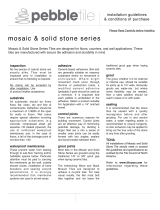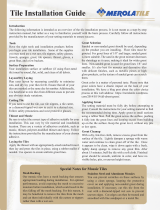WWW.SOLISTONE.COM
INFORMATION & GUIDELINES FOR THE INSTALLATION OF HANDPAINTED CERAMIC
RECOMMENDED INSTALLATION
Inspired by the earthen landscape of Mexico and the vibrant colors of traditional Spanish style,
SOLISTONE Hand-painted Ceramic tiles are available in a variety of beautiful surfaces and sizes.
These hand-painted tiles complement any indoor application.
Due to their hand painted nature, it is not unusual to find occasional flaws, crackling, or shade
variations within the tile. This variation is considered to be a desired feature in the product. Please
note that the Hand-Painted Ceramic tiles are not freeze-thaw resistant and will crack under these
conditions. These tiles are not suitable for flooring applications.
NOTE: this document contains only guidelines for the installation process. A professional installer
should always be consulted to discuss the specific parameters surrounding your project.
SUBSTRATES
All substrates should be firmly fixed, flat, clean, dry and free of contaminants such as dust, oil,
paint, sealers etc. to ensure proper adhesion. Painted surfaces must be scuffed or sanded for the
product and adhesive to bond correctly. Wet areas need special attention and require
appropriate substrates, e.g. concrete, cement boards (compressed sheet), and/or treated
plywood. The use of reinforced waterproof membranes is suggested.
WATERPROOF MEMBRANES
Waterproof membranes prevent leakage of water through to the sub-floor framing and/or
habitable spaces below. Particular attention must be paid to: carrying the membrane up the wall,
outside shower boxes, installation of bond breakers, and sealing around penetrations. It is
strongly recommended that membrane systems be used in all wet areas. Some systems may
involve the use of a primer.
CUTTING
Cuts can be done with either a wet saw or the tiles can be scored and snapped. To cut with a wet
saw, tape the area around the desired cut with masking or painter’s tape and run the saw through
the tape. Remove tape after cut is made. This will create a clean, straight edge and avoid
chipping the glaze.
ADHESIVE
Follow the adhesive manufacturer’s instructions carefully. We do not recommend one brand of
adhesive over another. Please check with your local tile supply store for alternative and
comparable products.
The manufacturer's literature will explain if the adhesive product is suitable for interiors and/or
exteriors, as well as walls and floors. Most thinset mortars (multi purpose and polymer modified
thinsets) are adequate for installing ceramic tile. A cement-based adhesive is generally suitable
on masonry substrates where no movement is anticipated. Where slight movement could occur





